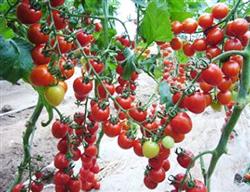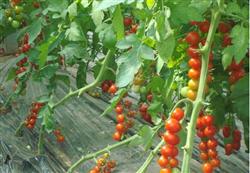Spring Seedling cultivation techniques of Cherry Tomato

Cherry tomato, also known as small tomato, mini tomato, table tomato, etc., its quality, flavor and nutritional value are better than ordinary tomato, and it has been very popular in the market in recent years. Now the spring open-field cultivation techniques are briefly introduced as follows: first, variety selection generally selects varieties with high quality, good taste, strong disease resistance, high yield per plant, non-cracking fruit and resistance to storage and transportation. Second, sowing seedlings can be raised in greenhouse or solar greenhouse with small hotbeds in the first and middle of February, and the seedlings can be transplanted at the age of 70-80 days. ① nursery bed is 1.2 to 1.5 meters wide and runs from east to west. About 15 kilograms of bed soil is needed for each square meter of seedbed. The preparation method of bed soil: add 2gram vegetable garden soil to 1gram high quality mature organic fertilizer, 25g 30g urea, 40g SSP, 5g carbendazim (or 6g Zinc Dyson), then cover it with plastic film for 2 to 3 days. ② seed treatment: soak the seeds in clean water for about 10 minutes, bleach the blighted seeds, then disinfect the seeds with 0.2%-0.3% pentachloronitrobenzene or carbendazim, soak the seeds in 20-30 ℃ warm water for 5-6 hours, and then fish them out to dry. The seeds can be sown when the radicle breaks through the seed coat after budding for 36 hours at the temperature of 25: 28 ℃. ③ sowing method sows 4 grams per square meter of seedbed. When sowing, first pour through the bottom water, then sprinkle the 2 beat 3 of the prepared bed soil on the bed surface, spread the seeds evenly, then cover the seeds with the remaining 1 big 3 bed soil, and finally cover the plastic film and buckle the small arch greenhouse film. ④ nursery bed management after sowing, the bed temperature was kept at about 25 ℃ in the daytime and 18 ℃ at night. Remove the plastic film in the morning when the germ is arching the soil. From unearthed to seedling stage, the temperature in the greenhouse kept 20: 25 ℃ in daytime and 10: 15 ℃ at night. Spray water if the soil dries and cotyledons roll up slightly. Third, when the seedlings are divided into two leaves at the right time, when there is no wind and sunny weather, the seedlings can be divided by root protection or nutritious soil, and the suitable area of the soil is 10 cm × 10 cm. After the bed soil is watered, use a small shovel to raise the seedlings, let the roots stretch in the soil when planting the seedlings, and cover the seedlings with plastic film in time. 4. After seedling separation, the grass curtain should be opened early and late. The ground temperature should be kept at 20: 22 ℃ and the greenhouse temperature at 24: 26 ℃ during the day, 18: 20 ℃ at night, and 16: 17 ℃ at night. After the plant was alive, the temperature and ground temperature of the seedling bed decreased by 2 / 3 ℃. After the seedlings have 4 or 5 true leaves, if the seedlings are raised in a nutrition bowl, the seedling bowl should be opened in time to prevent the seedlings from overgrowing. Moisture should be kept dry on top and wet on bottom. Extra-root topdressing should be carried out during the rapid growth period of seedlings. The seedlings were ventilated about a day before planting.
- Prev

Cultivation of cherry tomato in spring
Cherry tomato has high economic value and can be cultivated in spring in greenhouse. 1. Selection of varieties. Precocious varieties such as Jinzhu and Saint Virgin are selected. 2. Cultivate strong seedlings. The nutritious soil was prepared according to the proportion of 70% vegetable garden soil and 30% mature organic fertilizer, and then mixed with 5-10% human feces, 0.1% compound fertilizer and 0.2% superphosphate.
- Next

Planting and Management of Cherry Tomato in Spring
As a variety of tomato, cherry tomato is more and more welcomed by consumers. In order to achieve the goal of high yield when cherry tomato is planted in spring, it is necessary to do a good job of planting and management. 1. The planting time of cherry tomato in spring cultivation is generally arranged in February to March, and there is no seed in 3 years.
Related
- Where is it suitable to grow horseradish in China? it is expected to see the middle altitude horseradish in Alishan.
- How to prevent tomato virus disease reasonably? (Control methods included)
- Many people like to plant towel gourd on the balcony. What are the main points of this method and management?
- What crops can chili peppers be mixed with?
- Fertilization techniques and matters needing attention in Tomato
- What are the grafting techniques for peach seedlings in spring?
- Harm and control methods of root swelling disease of Chinese cabbage
- What are the pests of sweet potatoes? How to prevent and cure it?
- Symptoms, causes and Control methods of navel Rot in Tomato
- The cause of "Cucumber rotten bibcock" in Farmers' planting Cucumber and its Control Plan

